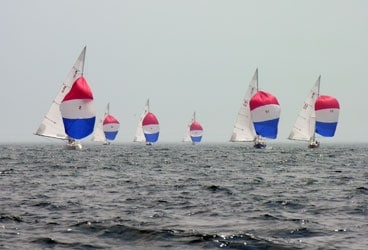
The winds were light for the International One-Design fleet at the 2006 Marblehead NOOD, and SailFlow’s Matt Corey is predicting more of the same for this year’s event.
Forecasting winds around Marblehead, Mass., is challenging due to the shape of the New England coast, which causes winds to vary considerably between inshore and offshore racecourses. The prevailing synoptic (large scale) winds are important to wind predictions, since a strong pre- or post-frontal blow can occur fairly evenly through the area. However, it’s those marginal days with weak synoptics when the sailor really needs to be on top of conditions-localized sea breezing can create large differences in both speed and direction depending on your proximity to the coast.

SailFlow| |Graphs show wind velocity from the 2006 Marblehead NOOD. The colored lines represent windspeed over time; the yellow arrows represent wind direction over time| During last year’s Marblehead NOOD we saw a weak, stalled frontal boundary that held a light southwesterly flow across the region for Friday and Saturday. This weak front drifted over the region late on Saturday (with a thunderstorm) and was offshore through Sunday. The graphs below show winds from last year’s NOOD. This sensor is a Sailflow exclusive station installed on Children’s Island (Cat Island), which is just north of the inner race circle. Study this graph closely, because you can clearly see that on both Friday and Saturday the sea breezes were able to isolate the southwesterly flow to the offshore course. Inside, the winds remained weak and very shifty with occasional right shifts to the south and south-southeast. When the sun got low on the horizon, the sea breeze weakened and the southwesterly flow was able to fill back into the inner course. Many computer models and forecasters might give a moderate southwesterly prediction for the entire area for this day, but as you can see from the graph, there is considerable variation. Reports from the off shore course were for solid southwesterly flow both days.
The Day 3 winds last year were peculiar in that they started northwesterly, as is common on a post frontal day, but the northwesterly flow was fairly weak, allowing the mid-day sea breeze to undercut, shifting the flow to southerly. A second wave came through and shot the flow back up from the west-northwest in the afternoon. Crazy stuff!
What about this year? This summer has seen an unusually high number of stalled fronts, occluded fronts, and backdoor cold fronts. We even saw a nor’easter try to spawn last week! The long wave pattern has been holding an upper trough over the east for a long time and this pattern should hold into this weekend. Weak frontal waves are often the result of this pattern, which makes long range forecasting quite difficult. Look for a weak southwesterly gradient into Friday and Saturday–not so unlike last year.
Knowing what forces are driving the winds is of great importance to gaining the edge on your competition. Sailflow.com provides real-time sensors as well as forecast products complimentary through the race period at www.sailflow.com/marblehead. In cooperation with North Sails, Sailing Weather Service is offering free precision race forecasts for this event. Sign up at http://na.northsails.com/ew/ew_main.taf









